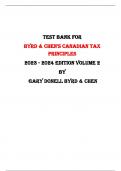Other
Byrd & Chen's Canadian Tax Principles Volume /2024 edition By Gary Donell Byrd & Chen |All Chapters, Latest-2023/2024|
- Course
- Institution
Byrd & Chen's Canadian Tax Principles Volume 2 /2024 edition By Gary Donell Byrd & Chen |All Chapters, Latest-2023/2024|
[Show more]



